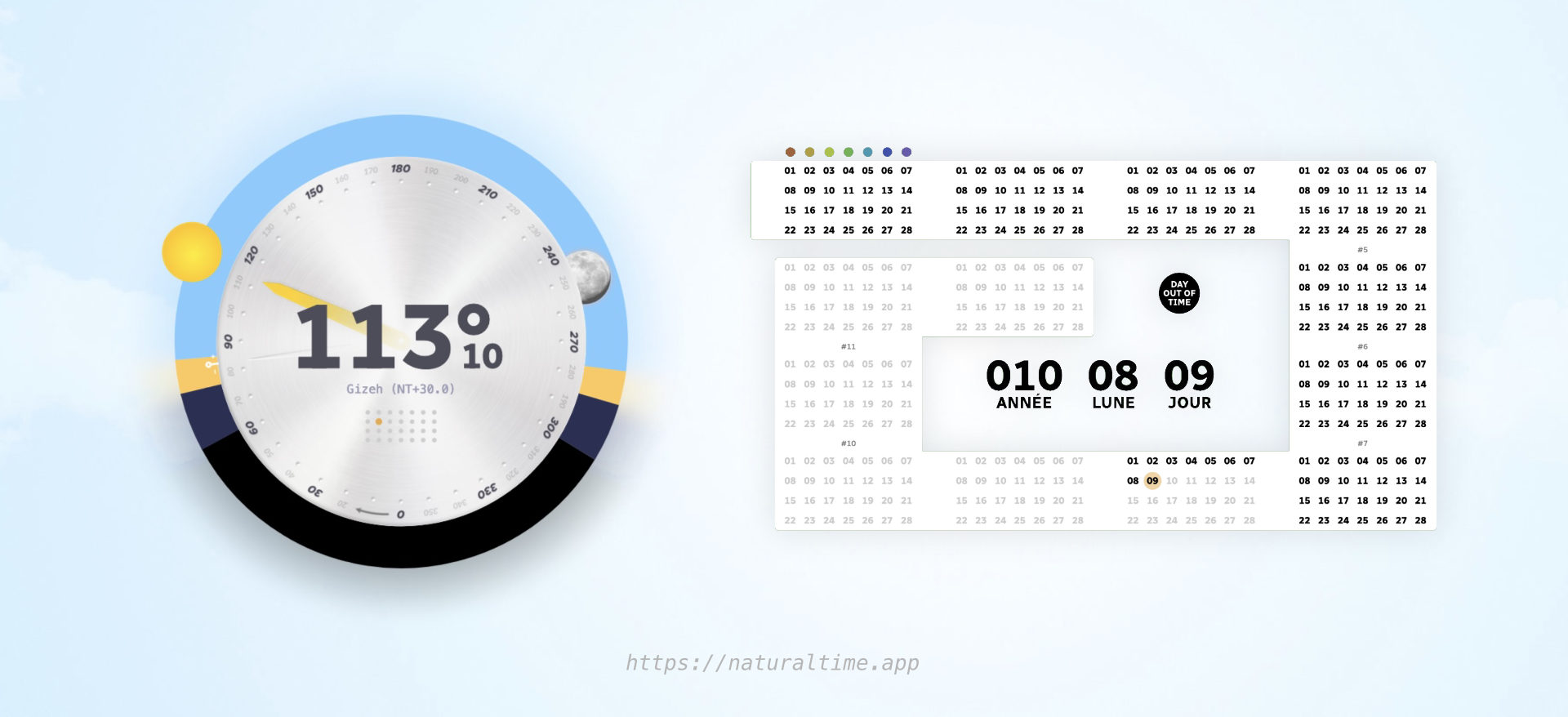Natural time - JavaScript
Natural time is a fresh, elegant, and coherent way of measuring the movements of time here on the Earth.
This new time standard is based on common sense and the observation of natural cycles.
Play with natural time at https://naturaltime.app/
JavaScript library
This repository contains the JavaScript implementation of natural time.
index.js: This class translates artificial dates to natural dates.
context.js: Collection of utility functions for calculating sky context and events like moon phase, sunrise and sunset ...
Natural time specifications
How are natural years, moons, days, and time defined ?
Read the full specifications of natural time here: github.com/sylvain441/natural-time
Web application
You can play with natural time at https://naturaltime.app/. It both works online and offline thanks to this JavaScript library.
Javascript API
If you know how to deal with typescript/typings/documentation this repo may appreciate your help. Contribute here
Instalation
Install NPM package with your terminal:
npm install natural-time-js
NaturalDate Class
The NaturalDate class translates artificial dates into natural dates.
import { NaturalDate } from 'natural-time-js';
let artificialDate = new Date();
let longitude = 5.2;
let naturalDate = new NaturalDate(artificialDate, longitude);Once instanciated, the naturalDate object holds many computed variables available for your usage:
unixTime; // Artificial gregorian date (UNIX timestamp)
longitude; // Longitude (between -180° to +180°)
year; // Current year (year 1: 2012/2013)
moon; // Current moon (between 1 and 14)
week; // Current week (between 1 and 53)
weekOfMoon; // Current week of the moon (between 1 and 4)
day; // Number of days passed since END_OF_ARTIFICIAL_TIME
dayOfYear; // Current day of the year (between 1 and 366)
dayOfMoon; // Current day of the moon (between 1 and 28)
dayOfWeek; // Current day of the week (between 1 and 7)
isRainbowDay; // True if current day is rainbow day
time; // Current time (between 0 and 359°999999...)
yearStart; // Beginning of the year at the current longitude (UNIX timestamp)
yearDuration; // Numbers of days in the current year (between 365 and 366)
nadir; // Beginning of the day at the current longitude (UNIX timestamp)
static END_OF_ARTIFICIAL_TIME = 1356091200000; // 2012-12-22 00:00:00 at +180° East;
static MILLISECONDS_PER_DAY = 86400000; // 24*60*60*1000Utility functions
naturalDate.toString() // "004)04)01 113°00 NT+5.2"
naturalDate.toDateString(separator = ')') // "004)04)01"
naturalDate.toTimeString(decimals = 2, rounding = 1) // "113°00"
naturalDate.toLongitudeString(decimals = 1) // "NT+5.2"
naturalDate.toYearString() // "004"
naturalDate.toMoonString() // "04"
naturalDate.toDayOfMoonString() // "01"More functions should be available later to make the NaturalDate class API mimic the native javascript Date class (ex: naturalDate.setYear(year)). Your help is welcome for this to happen ;-)
NaturalDateContext functions
The NaturalDateContext.js file contains utility functions to bring some astronomical context to the natural date (ex: altitude of the sun, phase of the moon).
import { NaturalSunAltitude, NaturalSunEvents, NaturalMoonPosition, NaturalMoonEvents } from 'natural-time-js/context';
// Gizeh pyramide
let latitude: 29.9791;
let longitude: 31.1341;
let naturalDate = new NaturalDate(new Date(), longitude);
NaturalSunAltitude(naturalDate, latitude);
// altitude: 31.779736404754367,
// highestAltitude: 62.32114911751647
NaturalSunEvents(naturalDate, latitude);
// sunrise: 70.56708493448893,
// sunset: 287.9105974344889,
// nightStart: 306.43507660115563,
// nightEnd: 52.13781826782227,
// morningGoldenHour: 80.8551891011556,
// eveningGoldenHour: 277.58920993448896
NaturalMoonPosition(naturalDate, latitude);
// phase: 74.86175469141531,
// altitude: 64.32391838504756,
// highestAltitude: 69.53997976716451
NaturalMoonEvents(naturalDate, latitude);
// moonrise: 139.14544743448894,
// moonset: 10.624722434488932Important !
Utility functions return time-distance from 0° or false if the event does not occur during this day (ex: no sunrise at the north pole during winter).
Roadmap
- Test in real life
- Add typescript compatibility
- Make NaturalDate feel like the Javascript native Date Class by adding features like
- getTime()
- setMoon()
- ...
- Make NaturalTime available for other programming languages
Contribute
Natural time is open to contributions from free-thinking minds. Find your way through Github or email at: sylvain441@proton.me to get in touch.
License
Read full license (Creative Common Zero)
Natural time is completely free to use, play, transform, improve... It operates under the law of Love. Follow your heart, fork it, spoon it! There is no need to ask for permission to do anything with it.
Natural time is supposed to bring joy and ease to human life, not the opposite. What you make out of it is up to you and the assistance of life forces.
Acknowledgments
Natural time has been baking for a long time in a goat's mind while traveling around the world. Infinite gratitude to my beloved friends Uncle Skywalker and Ik: your precious insights into the Mayan universe were so inspiring.
Special thanks to Don Cross, author of the Astronomy Library for calculating celestial body events. https://github.com/cosinekitty/astronomy
It was a real pleasure to give birth of natural time during the spring/summer of 2022 in the peaceful French alps.
